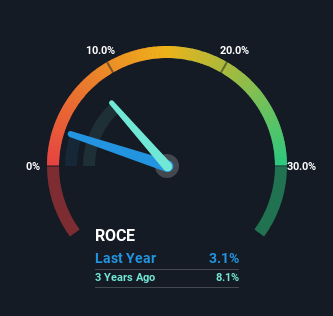- China
- /
- Semiconductors
- /
- SHSE:688372
Some Investors May Be Worried About Shanghai V-Test Semiconductor Tech's (SHSE:688372) Returns On Capital
Finding a business that has the potential to grow substantially is not easy, but it is possible if we look at a few key financial metrics. Firstly, we'd want to identify a growing return on capital employed (ROCE) and then alongside that, an ever-increasing base of capital employed. If you see this, it typically means it's a company with a great business model and plenty of profitable reinvestment opportunities. However, after briefly looking over the numbers, we don't think Shanghai V-Test Semiconductor Tech (SHSE:688372) has the makings of a multi-bagger going forward, but let's have a look at why that may be.
What Is Return On Capital Employed (ROCE)?
If you haven't worked with ROCE before, it measures the 'return' (pre-tax profit) a company generates from capital employed in its business. The formula for this calculation on Shanghai V-Test Semiconductor Tech is:
Return on Capital Employed = Earnings Before Interest and Tax (EBIT) ÷ (Total Assets - Current Liabilities)
0.031 = CN¥92m ÷ (CN¥3.4b - CN¥434m) (Based on the trailing twelve months to December 2023).
Thus, Shanghai V-Test Semiconductor Tech has an ROCE of 3.1%. Ultimately, that's a low return and it under-performs the Semiconductor industry average of 5.3%.
See our latest analysis for Shanghai V-Test Semiconductor Tech

In the above chart we have measured Shanghai V-Test Semiconductor Tech's prior ROCE against its prior performance, but the future is arguably more important. If you'd like, you can check out the forecasts from the analysts covering Shanghai V-Test Semiconductor Tech for free.
The Trend Of ROCE
In terms of Shanghai V-Test Semiconductor Tech's historical ROCE movements, the trend isn't fantastic. Around four years ago the returns on capital were 8.2%, but since then they've fallen to 3.1%. However it looks like Shanghai V-Test Semiconductor Tech might be reinvesting for long term growth because while capital employed has increased, the company's sales haven't changed much in the last 12 months. It may take some time before the company starts to see any change in earnings from these investments.
On a side note, Shanghai V-Test Semiconductor Tech has done well to pay down its current liabilities to 13% of total assets. So we could link some of this to the decrease in ROCE. Effectively this means their suppliers or short-term creditors are funding less of the business, which reduces some elements of risk. Some would claim this reduces the business' efficiency at generating ROCE since it is now funding more of the operations with its own money.
Our Take On Shanghai V-Test Semiconductor Tech's ROCE
In summary, Shanghai V-Test Semiconductor Tech is reinvesting funds back into the business for growth but unfortunately it looks like sales haven't increased much just yet. And in the last year, the stock has given away 36% so the market doesn't look too hopeful on these trends strengthening any time soon. On the whole, we aren't too inspired by the underlying trends and we think there may be better chances of finding a multi-bagger elsewhere.
Shanghai V-Test Semiconductor Tech does have some risks though, and we've spotted 2 warning signs for Shanghai V-Test Semiconductor Tech that you might be interested in.
If you want to search for solid companies with great earnings, check out this free list of companies with good balance sheets and impressive returns on equity.
New: Manage All Your Stock Portfolios in One Place
We've created the ultimate portfolio companion for stock investors, and it's free.
• Connect an unlimited number of Portfolios and see your total in one currency
• Be alerted to new Warning Signs or Risks via email or mobile
• Track the Fair Value of your stocks
Have feedback on this article? Concerned about the content? Get in touch with us directly. Alternatively, email editorial-team (at) simplywallst.com.
This article by Simply Wall St is general in nature. We provide commentary based on historical data and analyst forecasts only using an unbiased methodology and our articles are not intended to be financial advice. It does not constitute a recommendation to buy or sell any stock, and does not take account of your objectives, or your financial situation. We aim to bring you long-term focused analysis driven by fundamental data. Note that our analysis may not factor in the latest price-sensitive company announcements or qualitative material. Simply Wall St has no position in any stocks mentioned.
About SHSE:688372
Shanghai V-Test Semiconductor Tech
Shanghai V-Test Semiconductor Tech. Co., Ltd.
Good value with reasonable growth potential.
Market Insights
Community Narratives



